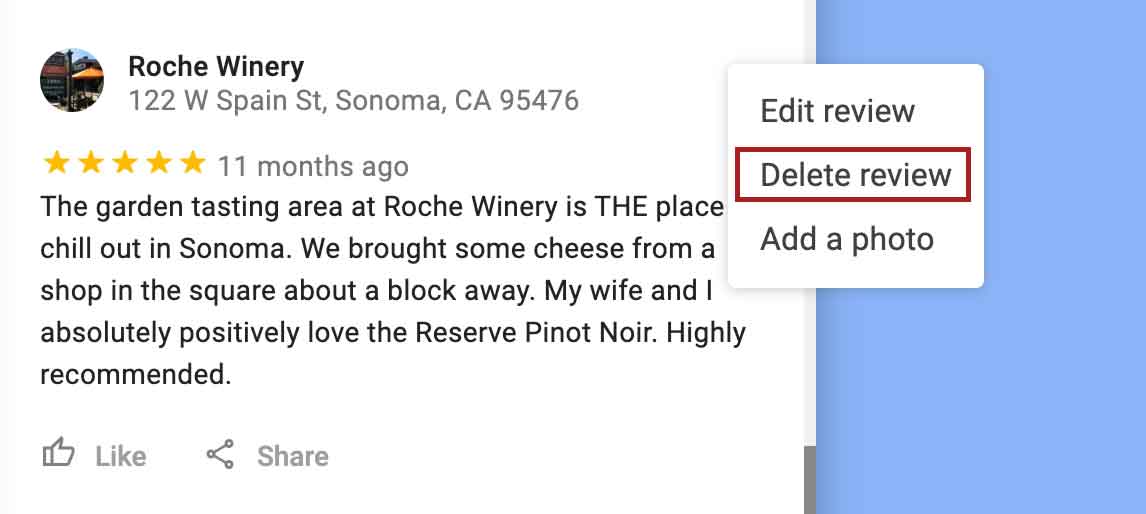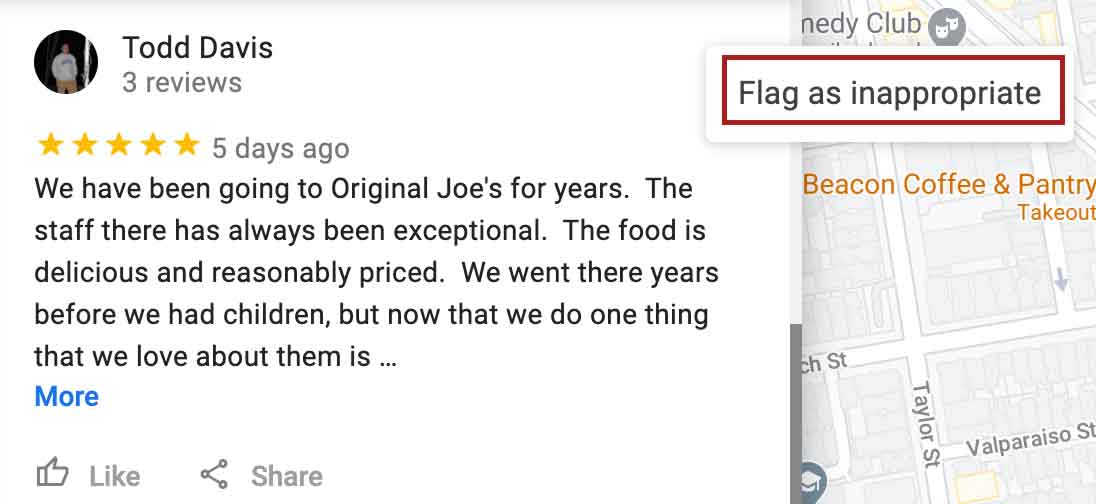How to Delete Google Reviews Permanently
We are asked how to delete Google reviews very often. Here is the advice we give our clients about removing Google reviews that might be problematic. We’ll also discuss options you can take when a review on Google cannot be removed.
Negative Google reviews are the plight of modern business. 91% of consumers between the ages of 18 and 34 trust online reviews as much as personal recommendations. With so much trust in reviews, you’ll want to make sure your Google reviews are an accurate representation of your brand.
This starts with good customer service, branding, and deliverables. But even if you’re doing everything right, you can still be the subject of displaced anger in online reviews. Your first thought may be to delete them — but this can be harder than it seems. Most reviews can’t simply be deleted, but there are a few cases where you can.
Google reviews can be deleted if the review violates Google’s terms of service or if you are the one who posted it. If neither of these two options fit, then the third option is to get the person who posted it to either remove or delete it. Here’s how each of those options works.
How to delete a Google review you made
If you posted the Google review, and want to remove it, here’s how:
1. Open Google Maps.
2. In the top left, click Menu.
3. Next, click “Your contributions” and then select “Reviews.”

To the right of the review you want to delete – select “…”

Select “Delete Review“.
How to delete a Google Review you did not make
This one is not as easy. First, find out if the review you want to remove is in violation of any Google Terms of Service. You can find them here.
The official list of terms of service violations include:
- Spam and fake content
- Off-topic
- Restricted content
- Illegal content
- Terrorist content
- Sexually explicit content
- Offensive content
- Dangerous & Derogatory Content
- Impersonation
- Conflict of Interest
Some of the more popular ways of removing Google Reviews for a ToS violation include Derogatory Content. For example, something that “harasses, intimidates or bullies an individual or group of individuals” is not permitted. Google will also remove content that contains “obscene, profane, or offensive language.” Reputation X has sometimes gotten content removed for Spam reasons, specifically “Your content should reflect your genuine experience.” For example, if a person posts on behalf of someone else – in other words, the person posting didn’t have a genuine experience. This works especially well for Yelp, by the way. For Google, you are going to want to flag the review as inappropriate.
How to flag a Google Review as inappropriate
1. Go to the review in question
2. Click the three little dots in the upper right of the review.
3. Select “Flag as inappropriate”

4. You can then report the type of violation
If you cannot get Google reviews removed due to ToS violations
While it takes work to maintain a positive online reputation, the good news is that you can often fix bad online reviews in three steps:
- Deal with a cold, hard truth: Is it your fault?
- Respond to the review and attempt to resolve matters privately – offline.
- Once the problem has been solved, ask the reviewer to update their review.
Facing the truth about Google reviews
The first step to rectifying a negative online reputation is acknowledging the problem. Are some of your customers’ critical reviews accurate? Maybe they aren’t, but if you cannot get a Google Review removed, you need to deal with it another way.
Remember that negative reviews are subjective and born of emotion. Most of the time people leave scathing reviews because they don’t feel heard or cared for in the way they expect.
Long after they’ve forgotten about your business that stink bomb of a review they left will still be there turning customers away.
They may be wrong, but it’s your job to put on your humble face and get the review removed or altered. Why? Because long after they’ve forgotten about your business that stink bomb of a review they left will still be there turning customers away. Suck it up.
While you want to conduct damage control privately, we don’t advocate sending your negative reviewers more negativity, either. There are several positive steps you can take to leverage your customer base to build a positive online reputation.
But, before you can dive into problem-solving and begin utilizing your happy customers, your first task is to figure out how we even got here.
1. Did they have a real reason to desecrate your once pristine rating?
When a customer negatively reviews your product, service, and/or delivery, it can hurt. Many business owners instinctively brush these negative reviews off.
After all, the customer knows nothing about how hard you and your team work to provide quality products or services at an affordable price, right? Besides, that customer might just have a bad attitude, or maybe they caught one of your employees on a bad day.
Could be.
Or, they might have encountered a real, justifiably negative aspect of your company.
Of course, not every review is entirely accurate, nor even coherent. Just like fake news, fake reviews are a lucrative industry.
Taking these overly critical reviews with a grain of salt doesn’t mean that you can afford to ignore them, however. Whether a real issue, a comment from a jaded individual, or outright slanderous, negative reviews of your business severely impact your bottom line, a single, first-page negative search result can result in a 22% decrease in your business!
No matter their cause, if you keep racking up negative reviews, your company will start losing out on cold, hard cash. In the worst-case scenario, if you let negative practices at your company continue, you are inviting disaster. At best, if you fail to put out a fire started by a single disgruntled reviewer, you risk burning the whole house down.
When you get burned by negative online reviews, you need to stop, drop, and evaluate. Is the complaint valid? After you discern what is going on, it is time to take appropriate action.
2. For the love of reputation: Take action
Bad customer reviews are not going to go away on their own. Whether you are addressing a legitimate concern or something resembling a conspiracy theory, you must always respond to bad customer service reviews.
When you have a flame war threatening your company’s online reputation, it’s best to take a direct approach.
Your goal is damage control, remediation, and, in an ideal world, rebuilding your reputation. Still, you will want to approach your negative reviewer cautiously.
Five do’s and don’ts when responding to Google reviews:
- Do: Acknowledge the customer’s complaint.
- Just being present demonstrates to other customers that you care.
- Don’t: Use canned responses!
- Take the time to address your critics personally. Your (prospective and repeat) customers notice this.
- Do: Apologize, and commit to taking action.
- All most people want is to feel seen and heard. Follow up with a genuine concern, and most critics will pipe down.
- Don’t: Use an argumentative tone.
- This will backfire so quickly that you’ll soon be nominated to the Internet troll Hall of Fame.
- Do: Set up a way to take the conversation offline.
- If this person is going to remain adamant that you are the worst in the industry, let them tell it to you or your customer service representative privately over the phone, rather than shout it out to countless potential customers online.
Publicly acknowledging that your customer has an issue, that you are sorry for their distress, and that you aim to rectify the situation is an instant public relations win. Follow this strategy consistently to build your company’s reputation, and make Google eat their words.
Remember: be genuine in your response, keep your cool, and move the conversation towards private conflict resolution if you can.
3. Resolve the matter privately
There is no use ignoring a bad online review. At the same time, instead of going in with the intent to remove a bad Google review, you can leverage it for the greater good – or, at least your own good.
While these incredibly vocal critics can be won over with compassion, a public forum is often not the place for conflict resolution. Rather than air both parties’ dirty laundry for all to see, try to encourage your upset customer to participate in a private call.
Once you are on the call, you do not want to seem aggressive. Quite the contrary, let your unhappy customer express themselves. Validate their concerns. Then, do everything you reasonably can to win them back over.
Remember: A $100 credit might be cheaper than thousands of dollars in lost opportunity the review could cause.
If you handle the situation well, you may earn a rare and extremely difficult reward. Treat your passionate critic properly, and they may just remove that bad Google review entirely.
Need more suggestions for how to handle a call with an upset customer?
One masterful approach to customer conflict resolution is Disney’s HEARD:
- Hear: let your customer speak. People just want someone to listen.
- Empathize: Tell them you know how frustrated you’d be in that situation.
- Apologize: Do this again, and again – and be sincere about it!
- Resolve: You know what to do; and if you don’t, ask your customer what you can do to right the situation.
- Diagnose: Figure out how and why this situation occurred, so you can fix bad Google reviews. This is not the time for an internal blame game, but an opportunity to fix your processes so that this problem does not occur again.
Negative reviews are unavoidable; every business eventually deals with negative online reviews. Take heart in the fact that the manner in which you respond to these will have a greater impact on your business than any review.
Because you can’t afford to ignore negative reviews, but also don’t want to engage in public shouting matches with a few trolls, you need to follow best practices when trying to fix Yelp and Google reviews:
- Observe and publicly acknowledge all negative reviews.
- Contact dissatisfied customers privately.
- Listen to them.
- Solve, or at least sympathize with their problem.
- Convert them into fans.
- Fix the flaws in your systems so this won’t happen again.
These are the steps you must take with each and every dissatisfied customer. Sound like hard work? Take a deep breath, because we are about to elevate your reputation management game!
4. Make it easy for happy customers to share their love
Want potential customers to see just how many fans you have? It’s not a magical coincidence that some companies have hundreds or thousands of positive online reviews.
Companies with tons of positive online reviews all share one trait in common: they make it easy for customers to leave positive reviews.
Know how you need to motivate your employees to maintain a positive company culture? You also must encourage customers to share their love of your company.
Whether you have managed to convince that unhappy critic to remove their bad Google review or not, an important component of your long-term strategy should be to drown out those few bad apples with a deluge of positive reviews. This kind of behavior is contagious.
Building up the number of online reviews you have brings secondary benefits as well, such as backlinks for SEO purposes. However, you can’t rely on folks to go out and enhance your brand’s reputation on their own initiative.
With a few simple tweaks to your order fulfillment process, you can prompt your customers, and begin racking up those positive online reviews:
- Ask for feedback (and educate on how to leave reviews)
- Emails, phone calls, and packaging prompt all increase review rates.
- Consider a quick video, clear infographic, or short blog post on your website that explains to less tech-savvy clients exactly how to write online reviews.

- Follow up to ensure positive interactions
-
- 3-5 days after a transaction or interaction, use email or phone (depending on your scale) to consult with your customers.
- This positive interaction is now at the forefront of their mind when they leave their review.
- Consider incentivizing
- Discounts towards future products or services.
- Coupons and gifts.
- Just be careful how, and to what extent, you incentivize. If you want to improve your reviews, your incentives should comply with terms and conditions.
Worried that some of the people you encourage to go public will write poor reviews? Consider these free audits of your company (albeit, not necessarily a professional one).
Going back to our earlier steps, this exercise is critical to your company’s long-term success. You must identify your customers’ pain points. Connecting with them, and trying to resolve their issues, is only going to make your team, and your reputation, stronger.
As long as you are actively involved in problem-solving, from processes to employee performance, no matter whether you are a product or service-based business, you will be well-poised to take this final, important step in building a positive online presence.
If you want to have your positive online reviews massively outnumber the bad ones, you need to be proactive in your engagement with customers. Beyond listening and responding to negative experiences, make sure you also gently push your customer base to share their positive opinions with as many people as possible.
Prevent bad online reviews
As we all know, the first step to fixing a problem is to acknowledge that you have one. Pay attention to all of your online reviews.
Don’t stop at lamenting bad customer reviews, but instead take time to internalize each complaint. Make sure to address your critics: listen to their issues, and do your best to solve their problems.
Finally, don’t stop at just treating the symptoms. If you want to start building brand health, get proactive. Encourage your fans to actively broadcast what is so great about your company.
When another negative review inevitably pops up, seize the opportunity to win over a new fan, and showcase your company’s supreme customer service.
Rebuilding your brand’s reputation after negative online reviews is no easy feat, but the return on investment is proportionately high.
Delete Google Reviews FAQs
How do I delete Google Reviews?
Google reviews can be deleted if the review violates Google’s terms of service or if you are the one that posted it. If neither of these two options fit, then the third option is to get the person who posted it to either remove or delete it
How do I reach out to a negative reviewer?
You’ll want to approach your negative reviewer cautiously. Start with acknowledging the customer’s complaint. Leave the canned apologies behind. Then, apologize and commit to taking action. Set up a way to take the conversation offline. At no point should you be argumentative, as this will backfire.
How do I prevent negative reviews?
Make sure to address your critics: listen to their issues, and do your best to solve their problems. But don’t stop at just treating the symptoms. If you want to start building brand health, get proactive. Encourage your fans to actively broadcast what is so great about your company.
Tags: Review Management.
